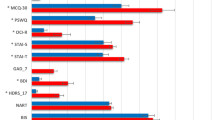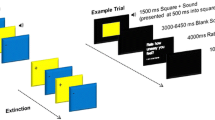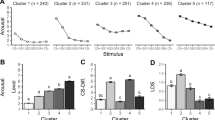Abstract
Abnormal fear responding to threat cues may contribute to the aetiology and maintenance of persistent fears and pathological anxiety. Chronic anxiety may also involve abnormal fear responding to ‘safety’ cues, which do not signal danger. Yet investigations of fear responding to acquired safety cues are scarce and the basis of such responding remains unclear. Moreover, previous studies do not distinguish between stimulus generalization (an associative mechanism based on perceptual similarity between threat and safety cues) and sensitization (a non-associative mechanism whereby fear responses to any novel, intense, or fear-related stimulus are temporarily elevated). This study investigated responses to acquired safety cues in volunteers with varying trait anxiety, using a novel fear conditioning paradigm designed to distinguish between effects of trait anxiety on generalization and sensitization. The paradigm used three conditioned stimuli: a threat cue (CS+) and two safety cues (CS−), one perceptually similar to the CS+ and one perceptually dissimilar. Conditioned fear to these cues was indexed by fear potentiation of the startle blink reflex, skin conductance responses, and self-report. To examine how trait anxiety moderated responses to safety cues, participants were divided into high and low trait anxiety subgroups. Startle, skin conductance, and self-reported fear measures indicated that generalization of fear occurred for the safety cue which resembled the threat cue, but not for the perceptually dissimilar safety cue, consistent with the stimulus generalization hypothesis. There was some evidence that stimulus generalization was exaggerated in anxious individuals. The current study sheds light on the mechanism by which fear responses to safety cues arise in healthy individuals, and offers some insight into the influence of this mechanism in chronic anxiety.



Similar content being viewed by others
References
Dunsmoor, J. E., Mitroff, S. R., & LaBar, K. S. (2009). Generalization of conditioned fear along a dimension of increasing fear intensity. Learning & Memory, 16, 460–469.
Fisher, P. L., & Durham, R. C. (1999). Recovery rates in generalized anxiety disorder following psychological therapy: an analysis of clinically significant change in the STAI-T across outcome studies since 1990. Psychological Medicine, 29, 1425–1434.
Grant, D. A., & Schiller, J. J. (1953). Generalization of the conditioned galvanic skin response to visual stimul. Journal of Experimental Psychology, 46, 309–313.
Hamm, A. O., Vaitl, D., & Lang, P. J. (1989). Fear conditioning, meaning, and belongingness: a selective association analysis. Journal of Abnormal Psychology, 98, 395–406.
Honig, W. K., & Urcuioli, P. J. (1981). The legacy of Guttman and Kalish (1956): twenty-five years of research on stimulus generalization. Journal of Experimental Analysis of Behavior, 36, 405–445.
Hovland, C. I. (1937). The generalization of conditioned responses. IV. The effects of varying amounts of reinforcement upon the degree of generalization of conditioned responses. Journal of Experimental Psychology. General, 21, 261–276.
Lau, J. Y. F., Lissek, S., Nelson, E. E., Lee, Y., Roberson-Nay, R., Poeth, K., et al. (2008). Fear conditioning in adolescents with anxiety disorders: results from a novel experimental paradigm. Journal of the American Academy of Child and Adolescent Psychiatry, 47, 94–102.
Lissek, S., Powers, A. S., McClure, E. B., Phelps, E. A., Woldehawariat, G., Grillon, C., et al. (2005). Classical fear conditioning in the anxiety disorders: a meta-analysis. Behaviour Research and Therapy, 43, 1391–1424.
Lissek, S., Biggs, A. L., Rabin, S. J., Cornwell, B. R., Alvarez, R. P., Pine, D. S., et al. (2008). Generalization of conditioned fear-potentiated startle in humans: experimental validation and clinical relevance. Behaviour Research and Therapy, 46, 678–687.
Lissek, S., Rabin, S. J., McDowell, D. J., Dvir, S., Bradford, D. E., Geraci, M., et al. (2009). Impaired discriminative fear-conditioning resulting from elevated fear responding to learned safety cues among individuals with panic disorder. Behaviour Research and Therapy, 47, 111–118.
Lissek, S., Rabin, S., Heller, R. E., Lukenbaugh, D., Geraci, M., Pine, D. S., et al. (2010). Overgeneralization of conditioned fear as a pathogenic marker of panic disorder. The American Journal of Psychiatry, 167, 47–55.
Mackintosh, N. J. (1974) The psychology of animal learning. London: Academic Press
Spielberger, C. D., Gorsuch, R. L., Lushene, P. R., Vagg, P. R., & Jacobs, A. G. (1983). Manual for the state-trait anxiety inventory (Form Y). Palo Alto: Consulting Psychologists Press, Inc.
Vervliet, B., Vansteenwegen, D., Baeyens, F., Hermans, D., & Eelen, P. (2005). Return of fear in a human differential conditioning paradigm caused by a stimulus change after extinction. Behaviour Research and Therapy, 43, 357–371.
Vervliet, B., Vansteenwegen, D., & Eelen, P. (2006). Generalization gradients for acquisition and extinction in human contingency learning. Experimental Psychology, 53, 132–142.
Vervliet, B., Kindt, M., Vansteenwegen, D., & Hermans, D. (2010). Fear generalization in humans: impact of verbal instructions. Behaviour Research and Therapy, 48, 38–43.
Acknowledgements
The authors wish to thank Elizabeth Michael for help with scoring the skin conductance data.
Author information
Authors and Affiliations
Corresponding author
Rights and permissions
About this article
Cite this article
Haddad, A.D.M., Pritchett, D., Lissek, S. et al. Trait Anxiety and Fear Responses to Safety Cues: Stimulus Generalization or Sensitization?. J Psychopathol Behav Assess 34, 323–331 (2012). https://doi.org/10.1007/s10862-012-9284-7
Published:
Issue Date:
DOI: https://doi.org/10.1007/s10862-012-9284-7




